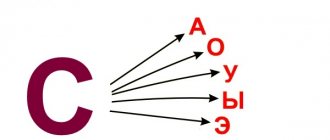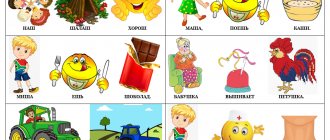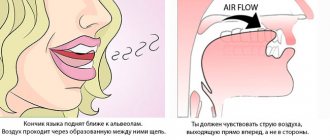Correction of dyslalia
Speech therapy work to correct dyslalia consists of the following stages:
- Examination of a child’s sound pronunciation;
- Correction of impaired speech sounds:
- Development of articulatory motor skills;
- Formation of skills in distinguishing speech sounds based on acoustic and articulatory features (work on phonemics);
- Production of disturbed sounds;
- Automation and introduction of formed sounds into speech.
The following stages are distinguished in the work on correcting sound pronunciation:
- Preparatory;
- Sound production;
- Sound automation;
- Sound differentiation.
The purpose of the preparatory stage is to prepare the organs of the articulation apparatus for the pronunciation of sounds: at this stage, the accuracy, strength and differentiation of movements of the articulation organs are worked out; work is underway to develop speech exhalation. At the preparatory stage, the child learns to perform articulatory gymnastics exercises, as well as various breathing exercises.
Important to remember! There is a basic set of exercises for developing the basic movements and position of the organs of the articulatory apparatus. Additional sets of exercises necessary for staging certain groups of sounds are selected for the basic complex.
Important to remember! Exercises to develop speech breathing help children develop targeted exhalation, which is necessary for mastering difficult-to-pronounce sounds.
Instructions for performing articulation gymnastics, as well as a list of exercises, can be read in our article
Video of articulation gymnastics:
Photos and videos of breathing exercises
Diagnosis of dyslalia
If parents notice that a child by the age of 5 does not pronounce a number of sounds, or pronounces them distortedly and incorrectly, the best decision in this case would be a consultation with a speech therapist.
The speech therapist conducts an examination of sound pronunciation using special picture material. This procedure is carried out individually and/or in the presence of the child’s parents or legal representatives.
The material for examining sound pronunciation includes sets of pictures for different groups of sounds. The selection of subject pictures is made in such a way that each of the sounds being examined is at the beginning, middle or end of the name word, since the sound is pronounced differently in different positions. Pronunciation is checked using visual material:
- in the group of whistling consonants [s] [s'] [z] [z'] [ts];
- in the group of sibilant consonants [w] [zh] [sh'] [h];
- in the group of sonorant consonants [р] [р'] [л] [л'] [j] [ja] [je] [jo] [jy] [ji];
- in the group of back-lingual consonants [k] [k'] [g] [g'] [x] [x'];
- in the group of voiced consonants [v] [v'] [b] [b'] [d] [d'];
- in the group of voiceless consonants [f] [f'] [p] [p'] [t] [t'].
The speech therapist selects at least three pictures for each sound position in the word (at the beginning, middle, end).
When examining sound pronunciation, the speech therapist notes the absence, replacement, confusion, and distortion of sound. If the child finds it difficult to name the picture, the speech therapist suggests repeating the word after him (i.e., reflected).
During a speech therapy examination, the specialist pays attention to and records:
- features of speech tempo;
- clarity of words pronunciation;
- correct pronunciation of words (by syllable structure);
- sonority of voice.
Important to remember! At the “Easy to Speak” speech development center, it is possible to undergo a comprehensive speech therapy examination and obtain a specialist opinion.
Differentiation of sounds K-T presentation on speech therapy
Slide 1
Sounds K-T Presentation for classes on differentiating sounds K-T Prepared by teacher-speech therapist GKUZ Orphanage Tyumen Bokova E.Yu.
Slide 2
The purpose of this speech therapy lesson is the differentiation of sounds K-T. Tasks solved during a speech therapy lesson: Correctional and educational: Form differentiation of sounds based on various analyzers: speech-auditory, speech-motor, visual. Correctional and developmental: Develop phonemic awareness. Develop the skill of sound-syllable analysis of words. Correctional and educational: Develop self-control skills. Preliminary work: staging and automation of sound staging and automation of sound
Slide 3
Hammer and Rain t-t-t k-k-k
Slide 4
What do the letters that represent sounds look like?
Slide 5
Game "Hammer-Rain". Instructions: “When I say (show) “rain”, you pronounce the sound K, when I say (show) “hammer”, you pronounce the sound T.”
Slide 6
Game "Slam-stomp". Instructions: “If you hear the syllable TA (a word with the sound “t”) - clap, if you hear the syllable KA (a word with the sound “k”) - stomp” ka - ta - kata - ta - ta - kata - ta - kata ta - ta - kata - ta - ta - kata - ta - ta - kata - ta -ta - kata - ta - ta - ta - taka - ta - ka- ka there, cube, basin, Tom, horse, Tolya, cinema, lotto, piece, this, salad, fireplace, robe, here, boar, plane, cuckoo, pilot, here, fireworks, com, sleeping, castle, sleeping, drinking , tongue, runs, bull, cries, poppy, sits, tank, eats, sings, like, being driven, no, godfather, screw, fog, side, rooster.
Slide 7
Game "Palm-fist". The child shows his palm if he hears a syllable with the sound T, clenches his palm into a fist if he hears a syllable with the sound K.
Slide 8
The tongue on the teeth hid deep t-t-t k-k-k
Slide 9
And the game “Show where the tongue is in the words” (the child points to the teeth or throat when pronouncing words) Piece, basin, there, like, wild boar, Tanya, Tolya, Kolya, kiwi, Tom, here, Cossack, Tima, notes, tongue , table, chair, horses, fireworks, piece, light, ticket, leaf, goats, writes, godfather, flies, flight, cabin, pilot, carpet, plane, sews, carries, lucky, sits, makes, lies, fireplace, zucchini
Slide 10
K and T in one word cabinet, rope, captain, hood, roll, skating, caftan, fleece, branch, baby, duck, cat, current, comet, room, candy, hoof, jacket, hammer, skein, hunter, knock, knock, traveler, skating rink, candy, pumpkin, whistle, scarf.
Slide 11
Tolya and Kolya
Slide 12
Tolya and Kolya go to visit (ta-yellow, ka-red)
Slide 13
Tolya and Kolya (help me separate the pictures, Wheel - with the sound k, Tolya - with the sound t) cubes cake basin wheel seal book
Slide 14
K and T in one word CAT KIT CABIN ROLLER TABLETS TAXI BUSH SCOOTER THIN ROLLING
Slide 15
K-t in phrases Wild duck Thin thread
Slide 16
In the text - Knock! Tuk! Knock! -Who is this? - It’s me, the cat, the thin claw!
Features of pronunciation of sounds T D
What typical mistakes do children make when pronouncing them? Systematically occurring speech disorders include:
- Replacing the front-lingual sounds “T – D” with the corresponding back-lingual “k – g”, for example, “k( t )igrenok”, “ing( d )yuk”.
- Mixing the front-lingual consonants “T – D” with the back-lingual “k – g”: cell - cell; glass - rolled.
- The sound “T” can be softened by “P” or “K”, for example: pichka - bird; drink, drink instead of dot.
- Persistent confusion T H (u t it - teaches, nine ( h)ka), T Ts (Pet ya - Petya, blooms - blooms).
In children with speech errors, one can observe the following construction of sentences: “Mom, where (where) are my tanfettes (sweets)?”, “There are sweets on the tartine (picture). Others immediately notice such violations, and parents may also detect incorrect articulation of the sound t : instead of leaving the tip of the tongue below, resting on the front teeth, the baby raises it to the palate.
Very often the reasons for incorrect pronunciation are:
- Disturbances in articulation (function of the speech organs).
- Low mobility of the lower jaw.
- Underdevelopment of auditory perception (the baby cannot distinguish sounds).
- It’s a bad example for adults when someone around them pronounces T D .
In any case, the diagnosis is made by a speech therapist, and parents are engaged in making sounds at home in accordance with his recommendations. Articulation gymnastics is very helpful in work, which should become a constant companion not only in classes, but also in everyday life.
Important: correction of the pronunciation of sounds N T D, as a rule, is carried out after simple sounds are clearly defined in the preschooler’s speech: vowels (a, u, o, i, e, s) and consonants (b b, p p, m m, v v, f f).
To examine the pronunciation of T D , you can offer your child a small test in the form of several exercises:
- Following the adult, pronounce sentences in which these sounds occur, for example: Dusya gives melon to Dasha. Aunt Tanya has notebooks on the table.
- Look at pictures that depict objects with sounds T D , for example: slippers, calf, tiger, axe, TV, cart, cake; melon, house, door, tree, girl, children.
- Among the pictures laid out on the table, find the one that the adult names: dot - daughter, cloud - dacha, duck - pipe, pond - twig, house - volume.
Work is required for the child whose speech cannot be traced with TD or is replaced by other sounds, and there is no differentiation (distinguishing sounds that are similar in sound).






